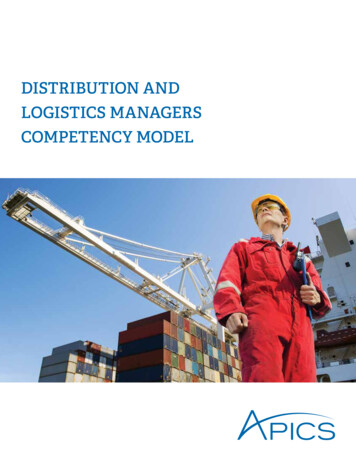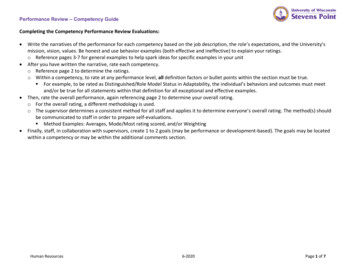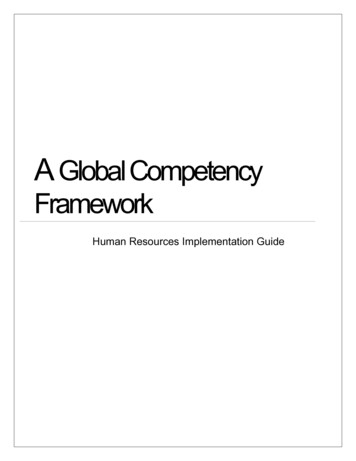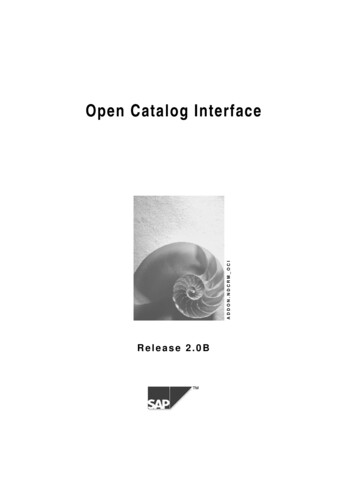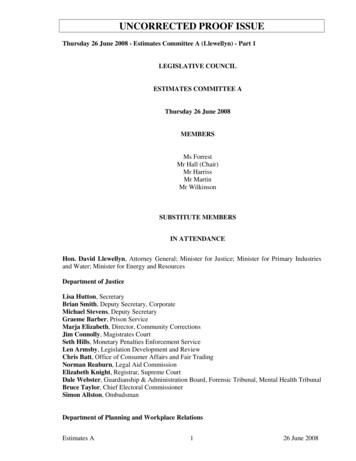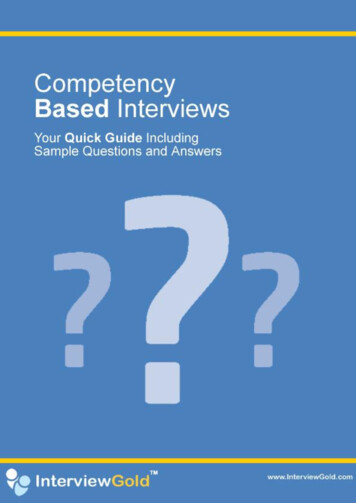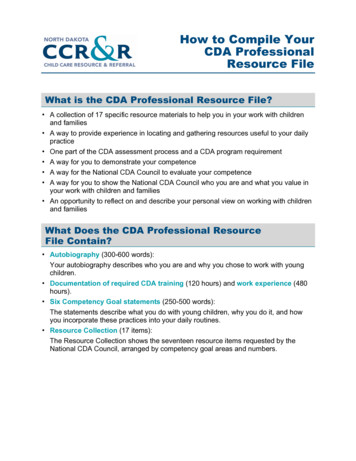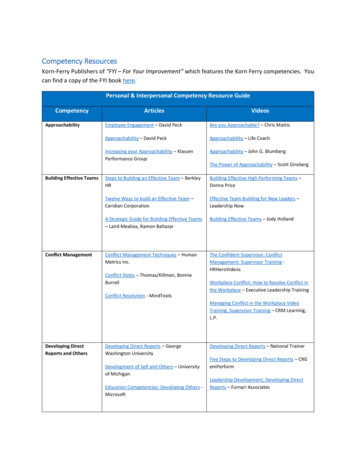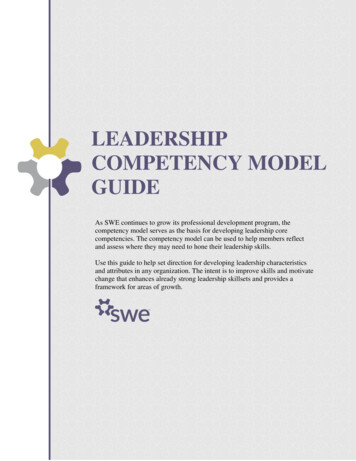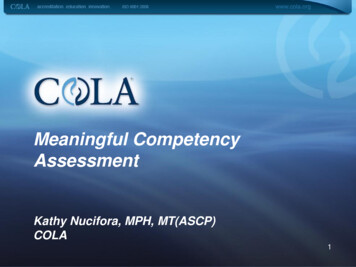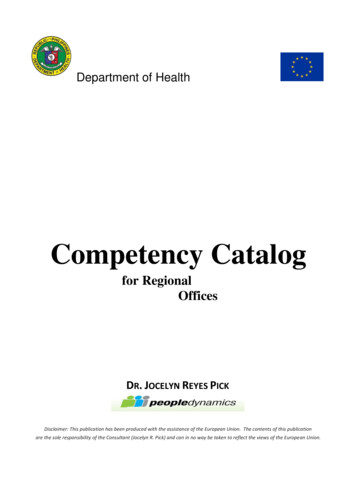
Transcription
Department of HealthCompetency Catalogfor RegionalOfficesDR. JOCELYN REYES PICKDisclaimer: This publication has been produced with the assistance of the European Union. The contents of this publicationare the sole responsibility of the Consultant (Jocelyn R. Pick) and can in no way be taken to reflect the views of the European Union.
Department of HealthTable of ContentsAbout the DOH Competency Catalog . iA. Purpose And Scope . iB.The Competency Catalog And Its Advantage To DOH Human Resource Management Division . iC.Understanding Of Competencies .ii D.Competency Model / Framework . iv E.Competency Dictionary . xiF. Competency Map / Standards . xiiiCore Competencies . 1Exemplifying Integrity . 1Professionalism . 2Service Excellence . 4Organizational Competencies . 5Effective Communication Skills . 5Effective Interpersonal Skills . 6Organizational Awareness and Commitment . 7Promoting Innovation . 8Leadership Competencies . 9Building Collaborative and Inclusive Working Relationship . 9Leading Change . 11Managing Performance and Coaching for Results . 13Thinking Strategically And Creatively . 15Technical Competencies . 16Achieving High Standards . 16Advocating Public Health . 17Biomedical/Biobehavioral Research Expertise . 19Building Relationship with Clients . 20Case Management . 23Communicating and Listening . 25Communicating Technical Information . 27Computer Literacy . 29Conflict Resolution . 31Data Gathering and Analysis . 32Data Management . 33Decision Quality . 34Developing Personal and Organizational Capability . 35Equipment, Materials and Supplies Management . 37Financial Acumen . 38Government Accounting and Budgeting . 39Government and Departmental Policies and Procedures . 41
Implementing Health Policies and Regulations . 42Influencing and Negotiating . 44Internal/External Institutional Awareness . 45Management Acumen . 46DOH COMPETENCY CATALOG FOR REGIONAL OFFICESDepartment of HealthManaging Work . 47Manpower Acquisition and Development . 48Organizing Communities . 50Procurement Planning and Management . 52Project/Program Planning and Management . 54Providing Support and Services . 56Records Management . 57Research and Analysis . 59Resilience . 60Respecting and Caring For Patients . 62Risk Management . 64Scientific Knowledge For Health/Medical Staff. 65Scientific Review Management. 67Statistical Research for Health . 68Technical Consulting . 69Technical Writing . 71Training Program Administration . 72Workforce Planning . 73
DOH COMPETENCY CATALOG FOR REGIONAL OFFICES
Department of HealthAbout the DOH Competency CatalogThis Competency Catalog was developed as a resource for officers, employees, health providers and clientsof the Department of Health (DOH). The Catalog provides an inventory of specific competencies necessaryfor effective job performance aligned to the following department’s objectives:1.2.3.4.Leadership in health;Enabler and capacity builder;Administrator of specific services;Continuous technical assistance to health providers and clients; and 5. Performance of its roleto improve the country’s health care system.A. PURPOSE AND SCOPEThe purpose of this Competency Catalog is to define competencies as an observable and measurableknowledge, skills, abilities or behavioral attributes that contribute to successful job performance foridentified positions across selected DOH Regional Offices, City Health Offices and Rural Health Units.The Catalog provides an understanding of the meaning, nature, and use of competencies, rubrics, andproficiency levels. Competency Models are written and compiled in the Competency Dictionaryprovided in the second part of this Catalog.B. THE COMPETENCY CATALOG AND ITS ADVANTAGE TO DOH HUMAN RESOURCE MANAGEMENTDIVISIONThis Competency Catalog provides a common and immediate reference to the DOH’s Human ResourceManagement Division to support its following activities:1. The Competency Catalog serves as immediate reference and guide of HRMD to support the followingactivities:a) Recruitment and Selection Development of Competency-based assessment toolsDevelopment of Competency-based Job Descriptionsb) Development of Competency-based Performance Management System by building a fairperformance appraisal system (results-focused) by structuring evaluation devices aroundcompetenciesc) Career Development of DOH Employees by establishing criteria for promotion or developmentof career path within the Departmentd) Learning and Development Competency-based curriculum development and designCompetency-based Training Needs AssessmentDOH COMPETENCY CATALOG FOR REGIONAL OFFICESi
Department of Healthe) Workforce Analysis and Planning in assessing current and future needs of DOH organizationbased on strategic plan, goals and objectives, priority programs and projectsf) Succession Planning to manage the gap that will occur when employees of key positions leave orare promotedg) Reward Management for positive recognition of employees’ work to motivate and improve theirperformance. This is also an important factor in recruitment and retention of high performingemployees.C. UNDERSTANDING OF COMPETENCIES1. Competency DefinitionA competency is defined as “a cluster of related knowledge, skills, and attitudes (KSA) that affectsa major part of one’s job (a role or a responsibility), that correlated with performance on the job,that 1) can be measured against well-accepted standards, and that 2) can be improved via trainingand development.” (Parry, 1996)2. Competency KSA Frameworka) Knowledge. Understanding acquired through training.b) Skills. Capabilities acquired through practice.c) Attributes. Inherent characteristics which are brought to the job.d) Behavior. The observable demonstration of competency, skill, knowledge and personal attributesrelated to excellent performance.Figure 1. The KSA FrameworkDOH COMPETENCY CATALOG FOR REGIONAL OFFICESii
Department of Health3. Characteristics of Competency Skills and knowledge that can be learnedExpressed in behaviorsDrives achievement of objectivesBuilding block of successCompetency must be demonstrated and hence, must be observable.Competency embodies the capacity to transfer skills and abilities from one area to anotherFigure 2. The Iceberg Model4. Benefits of Using Competenciesa) For the Organization Provides an integrating framework for designing HR systems such as recruitment andselection, learning and development, performance management, career development,workforce analysis and planning, succession planning, and rewards management (a.k.a.competency-based HR system). Align individual contribution to organizational goals since competency models are anchoredon strategic directions of the organization. Fosters performance-driven culture as it defines what an average job holder needs to do toattain superior performance, while it provides behaviorally-anchored standards forrecognizing exemplary performers. Helps in planning and budgeting HR development in a more rational and purposive way sincecritical competency gaps are systematically identified and addressed. When developing new position, enables organizations to “begin with the end in mind,” i.e.,defining expected outputs and outcome from the job rather than beginning with a list of tasksand activities. For succession planning, facilitates the selection and placement of best candidate or developsthe right competencies of potential successors to critical positions.DOH COMPETENCY CATALOG FOR REGIONAL OFFICESiii
Department of Healthb) For the Management Provides the foundation for sharpening their ability to select and hire best fit candidates Provides more objective performance standards since competencies are anchored on specifics,measurable behaviors Enables managers to clearly communicate performance expectations to staff Minimizes subjectivity in assessing performance Creates solid platform for dialogue between managers and staff on performance as welldevelopment and career-related issues Guides managers in identifying staff development initiatives in a more purposive andeffective mannerc) For the Employees Provides the foundation for sharpening their ability to select and hire best fit candidates Clarifies success factors in their current roles enabling them to give their best on the job For career planning, provides information on what it takes to move to their targeted positionswhether this is a lateral transfer or promotion Empowers staff to proactively seek competency-development activities (i.e., instead of justrelying on the sponsorship of their leaders or the organization)D. COMPETENCY MODEL / FRAMEWORKA competency model is a written description of the competencies required for successful or exemplaryperformance in a job category, work team, work setting, profession, organization or industry. It is theoutput of analyses conducted to differentiate high performers from average and low performers.Competency models represent the most critical knowledge, skills, and behaviors that drive successfulperformance. They are described in behavioral terms, using behavioral indicators so that thecompetencies are recognized when demonstrated.1. Elements of a Competency ModelA typical competency model has the following elements:a) Competency Title/Name. The name or title indicates the competency being described. Others referto this as competency label.Examples: Leading ChangeCustomer FocusSolving Problems and Making DecisionManaging InformationDOH COMPETENCY CATALOG FOR REGIONAL OFFICESiv
Department of Healthb) Competency Definition. This is a brief description of the competency, which provides the reader abroad understanding of the type of behavior expected of this competency.Example 1:Competency: Leading ChangeDefinition: Ability to initiate and facilitate change and motivate people to embrace it.Example 2:Competency: Customer FocusDefinition: Ability to meet and exceed customer/client needs and expectations.Some competency model builders use more rigorous definitions, which can be consideredas operational definitions of the competencies. The operational definition includes thecritical few tasks and outcomes required of the job holder. It may also state how output isdone and its desired outcome, and may describe important contextual factors (e.g.,technical requirements, legal certification requirements, and customer or clientrequirements) related to the acquisition of competencies.Example 1:Competency: Solving Problems and Making DecisionsDefinition:Task – Ability to resolve deviations and exercise good judgmentHow it is done – by using fact-based analysisOutcome – and generating and selecting appropriate course of action Output– to produce positive resultsExample 2:Competency: Customer FocusDefinition:Task – Ability to meet customer needs and expectationsOutput – by consistently adhering to and/or exceeding service standardsHow it is done – ensuring positive feedback on customer satisfactionOutcome – thereby developing and sustaining productive customer relationshipsKey Point: Whether to use a general definition or an operational definition of the competency is amatter of style and philosophy. The more specific the definition, the clearer the competency iscommunicated to all users.Sample Diagram of Competency ModelStrategic IntentsDOH COMPETENCY CATALOG FOR REGIONAL OFFICESv
Department of HealthAchieving ResultsFigure 3. Sample Competency Model of DOH’s Organizationc) Competency Rubric. A rubric is an explicit set of criteria used for assessing a particular typeof work or performance. It articulates in progressing order the quality of each criterion, fromthe simplest manifestation of desired behaviors to the most complex. A rubric may also includework and performance samples that typify each of the levels.i.Progression Levels of CompetenciesDOH COMPETENCY CATALOG FOR REGIONAL OFFICESvi
Department of Healthii.Other dimensions to determine Progression Levels of CompetenciesSource: Annex 3 or PAHRODF’s Guidebook on Competency ModelingFigure 4. Rubrics: Leveling Guide for CompetenciesThe rubrics provide concrete parameters in developing a proficiency matrix or table, whichreflects progressive levels of mastery in particular behaviors or areas of work under acompetency. A set of rubrics that is generated through consultation and agreed upon by keyclients in the organization is a prerequisite for the development of proficiency levels.DOH COMPETENCY CATALOG FOR REGIONAL OFFICESvii
Department of HealthSource: PAHRODF’s Guidebook on Competency Modeling and ProfilingFigure 5. Example of how competency levels are created based on rubricsd) Proficiency Levels – serve several purposes. They facilitate comparison of jobs and roles interms of competency requirements and proficiency levels needed using a common incrementalscale. For example, oral communication skills may be a requirement for most entry level jobsas well as for executive levels. However, the degree of oral communication proficiency neededat these two levels may be quite different. This information is necessary input to DOH’sselection, hiring and placement system.DOH COMPETENCY CATALOG FOR REGIONAL OFFICESviii
Department of HealthSource: HRMD, Department of HealthFigure 6. DOH’s Competency Proficiency Levelse) Behavioral Indicators – A behavioral indicator is a statement of what can be observed froman individual manifesting the competency. It provides objective evidence that the individualpossesses the competency and shows what effective performance looks like.Example 1:Competency: Personal EffectivenessDefinition: Maintains effective behavior in challenging situations having the resilience tobounce back in the fact of setbacks; demonstrates a strong desire to advance oneself andone’s career, propelled by confidence and belief in one’s capacities, and tempered byhonesty and integrity in one’s undertaking.Sample Behavioral Indicators Able to overcome obstacles within his/her area of control and takes responsibility for resultsof own action (manifested behavior); does not blame others (missing behavior)DOH COMPETENCY CATALOG FOR REGIONAL OFFICESix
Department of Health Avoids transactions and interactions that exposes himself/herself to personal gain or conflictof interest (missing behavior)Example 2:Competency: Customer FocusDefinition: Ability to meet customer needs and expectations by consistently adhering toand/or exceeding service standards ensuring positive feedback or customer satisfactionthereby developing and sustaining productive customer relationships.Sample Behavioral Indicators Acts to prevent problems, reporting issues where necessary (manifested behavior) Avoids overpromising service delivery to clients (missing behavior)Key Points: Not all behavioral indicators that are generated and captured in the competency table may beapplicable to a job or role. They are simply sample of behaviors and are by no means an exhaustive list normeant to be used as behavioral checklist. Rather it is an indicator to help guide assessment of competence.Formula for stating behavioral indicators:Behavioral indicators action verb object qualifier or criterionExample 1:Example of a well-stated behavioral indicatorCompetency: Managing InformationDefinition: Describes and distinguishes data or information that is relevant to the job and thevalue this brings to one’s functional role, group or the organization.Example 2:Example of a well-stated behavioral indicatorCompetency: Customer FocusDefinition: Follows up with clients during and after delivery of services to ensure that theirneeds have been metLegend: Action VerbObjectQualifier, CriterionCharacteristics of ideal Behavioral Indicators: Concrete and specific behaviors that are observable, verifiable and must lend themselves tomeasurementDOH COMPETENCY CATALOG FOR REGIONAL OFFICESx
Department of Health Illustrate what a person does, as if the competency has already been acquiredCan be taught or altered through training, coaching and other development strategiesE. COMPETENCY DICTIONARY1. IntroductionDOH, in its effort to build Competency Models for its organization, establishes CompetencyDictionary that compiles in a single document the competencies needed across its selected RegionalOffices, City Health Offices and Rural Health Units.a) Competency Dictionary represents the Core, Organizational, Leadership, and Technicalcompetencies that apply to jobs at the selected DOH’s Regional Offices, City Health Offices andRural Health Units.b) PurposeTo enhance Human Resource Management system on the following areas: Recruitment and SelectionLearning and DevelopmentPerformance Management SystemSuccession Planningc) DOH’s Competency Dictionary includes needed competencies for positions / job roles in its selectedhealth offices and units. These competencies are categorized as follows:i.Core CompetenciesThese are characteristics that collectively lead to desired outcomes in the Department.Sometimes referred to as foundational or organizational competencies, these consist ofbehaviours that everyone in the organization must possess regardless of function becausethey drive overall desired results. Core competencies are founded on the DOH’s mission,vision and values, including culture (the way things are done in DOH).ii.Organizational CompetenciesThese are competencies required to perform similar functions within DOH; and areexpected of majority of positions in the Department. These competencies cannot beconsidered as core competencies though because not everyone is required to possess them.iii.LeadershipCompetenciesThese are knowledge, skills and behaviours needed to perform management / leadershipfunctions and processes. These are expected of individuals who supervise staff, or whowork through others or a team to get the job done.iv.Technical or Functional CompetenciesThese are behaviors or abilities that pertain to a specific body of knowledge and skillsrequired to perform a function or job. It includes abilities to use procedures, techniques andDOH COMPETENCY CATALOG FOR REGIONAL OFFICESxi
Department of Healthknowledge of a specialized field. Technical competencies are linked to job roles and theway in which they interact with other roles. These competencies may be transferable if aperson accepts a similar job in another organization.Figure 7. Sample of DOH Competency DictionaryF. COMPETENCY MAP / STANDARDS1. Introductiona) Competency Map identifies the key competencies for an organization and/or job andincorporating those competencies throughout the various HR core processes (i.e. recruitment andselection, career development, learning and development, and performance management system).DOH has undergone job analysis and other methodologies which results helped develop thecompetency-based job descriptions. The competency-based job description serves as the basisin the establishment of the Department’s Competency Map. The Competency Map illustratesthe competencies which are categorized as Core Competencies, Organizational Competencies,Leadership Competencies and Technical Competencies needed to be able to meet the demandsin employee’s particular role and help him/her develop toward the ultimate success of DOH’sorganization.b) Purpose of Competency MapDOH COMPETENCY CATALOG FOR REGIONAL OFFICESxii
Department of HealthTo enhance Human Resource Management system in the following areas: Recruitment and Selection Learning and Development Performance Management System Succession PlanningDOH COMPETENCY MAPProficiency Levels - 1 – Basic; 2 Intermediate; 3 – Advanced; 4 – ExpertDOH COMPETENCY CATALOG FOR REGIONAL OFFICESxiii
Department of HealthCompetency Dictionary1DOH COMPETENCY CATALOG FOR REGIONAL OFFICES
Department of HealthCore CompetenciesEXEMPLIFYING INTEGRITYDefinition Ability to establish and maintain social, ethical and organizational norms within the organization and towards clients in accordance to the Code of Conductand Ethical Standards for Public Officials and Employees (RA 6713).Proficiency LevelBASICCore Description1Exhibits an honestbehaviorBehavioral IndicatorsDemonstrates openness and honesty with clients and others Devotes to meet the organization's standards 360 (subordinates,peers, supervisors)ReviewActs professionally at all times, is punctual, reliable, and prompt in deliveringservicesINTERMEDIATEADVANCED23Means of VerificationIs more critical ofbehavior’s implicationsto self, clients, andorganization inaccordance to RA 6713Analyzes own performance truthfully, and offers ideas and gives feedback forimprovementExpects uprightnessfrom the team and/ororganization andadherence to RA 6713Includes integrity checks in the team’s performance reviewIs flexible to meet the needs of the organization and clientsRefuses and/or avoids malicious and unethical situationsFeedback Reports Feedback Reports 360 (subordinates,peers, supervisors)ReviewEvaluationofCustomer /ClientSatisfaction SurveyformUnderstands and actively promotes the organization's standards and ethics tocolleagues and to others outside the organizationMonitors self and others to acting in accordance with the organization’s standards andvaluesEXPERT4Protects the integrity andimage of the organizationby adhering to RA 6713Upholds at all times the fundamental values of good governance Ensures organizational compliance with legislation, regulatory requirements and bestpracticesMemorandumCirculars Ordinances, ExecutiveOrders Administrative OrdersStands up publicly for beliefs and challenges the unethical behavior of othersDOH COMPETENCY CATALOG FOR REGIONAL OFFICES1
Department of HealthPROFESSIONALISMDefinition Ability to exemplify high standards of professional behavior as a public servant, adhering to ethical as well as moral principles, values and standards of publicoffice.Proficiency LevelCore DescriptionBehavioral IndicatorsMeans of VerificationBASIC1Understands duties andsets quality benchmarksfor self performanceWorks without supervision, appears confident in person, presents oneself strongly Feedback ReportsEnsures that outputs produced and work performed are within set standards andcomply with specifications Accomplishes IPCR,RFASeeks for instruction or clarification on tasks or work to ensure accurate and timelyproduction of outcome or results Prepared CSSReport, Minutes ofMeetings Evaluation ofCustomer /ClientSatisfaction SurveyformDemonstrates trustworthiness by protecting sensitive or confidential information,following required proceduresMonitors own performance and improves it if current status does not match the idealor agreed expectationsProvides guidance on operations and technical issues to staff to ensure accurate andtimely production of outcome or resultsManifests positive disposition despite heavy workload, working hours or unusualchallenges encountered in the workplace 360 (subordinates,peers, supervisors)Review Prepared CSSReport, Minutes ofMeetings EvaluationofCustomer /ClientSatisfaction SurveyformTakes action to improve own abilities in line with career goals, includingvolunteering for “stretch” assignments and taking on additional responsibilitiesEncourages others to maintain a positive attitude towards work, meeting tightdeadlines and the needs of demanding clients 360 (subordinates,peers, supervisors)Review Prepares CSSSeeks guidance from immediate superiors on how to improve performanceINTERMEDIATEADVANCED23Assists team and/orclients to comply toprinciples, values, andstandardsAnalyzes self andendorses ways tocolleagues to
Competency Models are written and compiled in the Competency Dictionary provided in the second part of this Catalog. B. THE C . Provides an integrating framework for designing HR systems such as recruitment and selection, learning and dev
